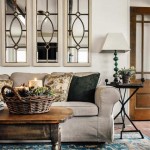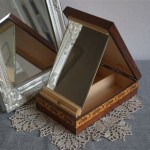The Enduring Appeal of Gold Gilt Floor Mirrors
Gold gilt floor mirrors represent a marriage of functionality and artistry. They serve as more than just reflective surfaces; they are statement pieces capable of transforming the aesthetic of a room, adding a touch of luxury, grandeur, and historical elegance. The use of gold leaf, or gilt, to adorn the frames of these mirrors distinguishes them from simpler designs and contributes significantly to their perceived value and decorative impact.
The practice of applying gold leaf, a process known as gilding, dates back to ancient civilizations. Evidence of gilded objects has been found in Egyptian tombs, Roman ruins, and throughout medieval Europe. Gold, prized for its inherent beauty, resistance to tarnishing, and symbolic association with wealth and power, became a material of choice for embellishing objects of significance. The application of gold leaf to mirror frames was a natural extension of this practice, elevating a utilitarian object into a work of art.
The historical context surrounding gold gilt floor mirrors is rich and diverse. During the Baroque and Rococo periods, elaborate gilded mirrors were integral components of aristocratic interiors. Their ornate frames, often adorned with intricate carvings and sculptural details, reflected candlelight and amplified the sense of opulence and grandeur. These mirrors were not merely decorative elements; they were symbols of social status and refined taste. The techniques used to create these mirrors were highly specialized, requiring skilled artisans with years of experience in carving, gilding, and glass making.
The Craftsmanship of Gilding
The creation of a gold gilt floor mirror is a multi-stage process that demands precision and expertise. The foundation of the frame is typically constructed from wood, chosen for its stability and ability to hold intricate carvings. Various types of wood, such as oak, mahogany, or softer woods like pine, may be used depending on the desired level of detail and the overall design. Once the wooden frame is constructed, it undergoes a process of preparation, which often includes applying gesso, a white plaster-like substance that provides a smooth and receptive surface for the gold leaf.
Gesso serves several crucial functions. It fills in any imperfections in the wood, creates a uniform texture, and provides a slightly porous surface that allows the gold leaf to adhere properly. The application of gesso is typically done in multiple layers, each layer being carefully sanded to achieve a flawless finish. This meticulous preparation is essential for ensuring the longevity and beauty of the gilded surface.
The actual gilding process involves the application of extremely thin sheets of gold leaf, typically measuring only a few microns in thickness. These delicate sheets are so thin that they can be easily torn or damaged by even the slightest breeze. Gilders use specialized tools, such as a gilder's tip (a flat brush made of badger hair) and a gilder's knife, to handle and apply the gold leaf with precision. The gold leaf is carefully lifted from a cushion and transferred to the prepared surface, where it is gently pressed into place.
There are two primary methods of gilding: water gilding and oil gilding. Water gilding, also known as traditional gilding, involves applying the gold leaf over a layer of adhesive that is activated with water. This method produces a lustrous and highly reflective finish, but it is also more complex and requires greater skill. Oil gilding, on the other hand, uses an oil-based adhesive, which is easier to apply and more durable. Oil gilding typically results in a slightly less brilliant finish than water gilding but is suitable for both interior and exterior applications.
Once the gold leaf has been applied, it is burnished or polished to bring out its brilliance and create a smooth, even surface. Burnishing is typically done with agate stones, which are carefully rubbed over the gold leaf to compress and smooth the surface. This process requires a delicate touch and a thorough understanding of the properties of gold leaf to avoid damaging the delicate surface.
The final step in creating a gold gilt floor mirror involves applying a protective coating to the gilded surface. This coating helps to protect the gold leaf from scratches, tarnishing, and other forms of damage. Various types of coatings can be used, including varnishes, lacquers, and waxes. The choice of coating depends on the desired level of protection and the overall aesthetic of the mirror.
Design Variations and Styles
Gold gilt floor mirrors are available in a wide range of designs and styles, reflecting different historical periods and aesthetic preferences. From the ornate and elaborate designs of the Baroque and Rococo eras to the more streamlined and minimalist styles of the Art Deco and Mid-Century Modern periods, there is a gold gilt floor mirror to suit virtually any interior design scheme. The design of the frame, the type of carving, and the degree of ornamentation all contribute to the overall character of the mirror.
Baroque and Rococo mirrors are characterized by their extravagant ornamentation, intricate carvings, and asymmetrical designs. These mirrors often feature scrolling foliage, floral motifs, and mythological figures. The use of gold leaf is typically lavish and extensive, covering almost the entire surface of the frame. These mirrors are statement pieces that are designed to command attention and create a sense of drama and opulence.
Neoclassical mirrors, inspired by the art and architecture of ancient Greece and Rome, are characterized by their symmetry, balance, and restrained ornamentation. These mirrors often feature simple geometric shapes, fluted columns, and classical motifs such as laurel wreaths and acanthus leaves. The use of gold leaf is typically more subtle and refined, highlighting the clean lines and elegant proportions of the frame.
Art Deco mirrors, popular in the 1920s and 1930s, are characterized by their geometric shapes, bold lines, and use of modern materials. These mirrors often feature stylized representations of natural forms, such as sunbursts and stylized flowers. The use of gold leaf is typically combined with other materials, such as chrome, glass, and lacquer, to create a sleek and sophisticated look.
Mid-Century Modern mirrors, popular in the 1950s and 1960s, are characterized by their minimalist designs, clean lines, and use of natural materials. These mirrors often feature simple wooden frames with a subtle gold gilt accent. The emphasis is on functionality and understated elegance, reflecting the modernist aesthetic of the period.
Contemporary interpretations of gold gilt floor mirrors often blend traditional techniques with modern design sensibilities. These mirrors may feature innovative shapes, unexpected materials, and unconventional applications of gold leaf. The goal is to create a unique and expressive piece of art that reflects the personality and style of the homeowner.
Placement and Impact on Interior Design
The placement of a gold gilt floor mirror within a room can significantly impact the overall aesthetic and ambiance. These mirrors can be used to create a variety of effects, from enhancing natural light and expanding the perceived space to adding a focal point and creating a sense of drama and sophistication. The size, shape, and style of the mirror should be carefully considered in relation to the size and layout of the room.
One of the primary benefits of using a floor mirror is its ability to reflect light and brighten up a space. Placing a mirror near a window or other source of natural light can amplify the amount of light that enters the room, making it feel more airy and spacious. This is particularly effective in rooms that are small or have limited natural light.
Floor mirrors can also be used to create the illusion of more space. By reflecting the surrounding environment, a mirror can make a room feel larger and more open. This is especially useful in narrow hallways or small bedrooms where space is at a premium. The placement of the mirror is key to achieving this effect. Ideally, the mirror should be positioned in a way that reflects a significant portion of the room, creating a sense of depth and perspective.
Gold gilt floor mirrors can be used to create a focal point in a room. By placing the mirror in a prominent location, such as against a feature wall or at the end of a hallway, it can draw the eye and create a sense of visual interest. The style and design of the mirror should complement the overall aesthetic of the room, enhancing its existing features and creating a cohesive look.
The use of gold gilt in the frame adds a touch of luxury and sophistication to any space. The warm, reflective quality of the gold can create a sense of warmth and ambiance, particularly when combined with soft lighting. The gold gilt can also complement other metallic accents in the room, such as brass fixtures, silver candlesticks, or bronze sculptures.
In addition to their aesthetic benefits, floor mirrors also serve a practical purpose. They provide a full-length view of one's reflection, making them useful for dressing and grooming. The height and angle of the mirror can be adjusted to provide the most flattering and functional view. The placement of the mirror should be convenient and accessible, allowing for easy use and maximum benefit.
Ultimately, the selection and placement of a gold gilt floor mirror are matters of personal taste and design preference. The key is to choose a mirror that complements the existing decor, enhances the overall ambiance of the room, and reflects the individual style and personality of the homeowner. With careful consideration and attention to detail, a gold gilt floor mirror can become a cherished and enduring feature of any home.

Flophouze Container Hotel Magnificent Antique Gold Gilt And Plaster Mirror

Gold Wall Floor Mirror Italian Vintage Style Handmade Carved Wooden Frame Leaf Vertical Victorian Baroque French Design

Large Standing Full Length Gilt Gold Framed Vintage Style Mirror Leaner By Smitten Furniture

Glorious Gilt Mirror Full Length French Style Bedroom In Gold With Ornate Crest

Glorious Gilt Mirror Full Length French Style Bedroom In Gold With Ornate Crest

Now Sold Large Antique Gilt Mirror Gold Home Decor Room

Antique French Gilt Floor Mirror With Original Glass Laurier Blanc Unique Home Decor From Around The World

Large French Panelled Gold Gilt Mirror 1900 For At Pamono

Antique French Gold Leaf Gilt Louis Philippe Mirror With Crest

19th Century Carved Gilt Gold Pier Console Floor Or Over The Mantle Mirror Mantel Mirrors Wall








